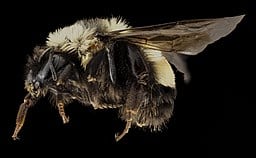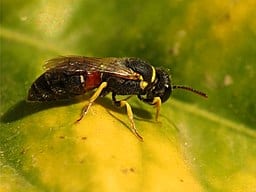Unfortunately, these prolific pollinators have been declining in numbers in the recent years. This is a problem we need to solve if we want to continue living in abundance with a diversity of food. By the end of this article, you will learn which bees are endangered, the driving forces of their endangerment and what we can do to help save them.
Are Bees endangered? To date, two bee species are declared endangered according to the US Fish and Wildlife Service. In 2016, the seven Yellow Faced Bee Species which are native to Hawaii was declared endangered & protected under the Endangered Species Act. A year after, the Rusty Patched Bumble Bee was also included in the list due to its decrease in number by 87 percent.
Bees are flying insects under the order, Hymenoptera and family Anthophila. They range in sizes from 2 to 39 millimeters in length. There are about 20,000 known species of bees categorized in seven different biological families namely, Andrenidae, Apidae, Colletidae, Halictidae, Megachilidae, Melittidae and Stenotritidae.
Table of Contents
Endangered Bees
Recent studies revealed that about 1200 wild bee species might be at risk of extinction. However, two bee species have recently been declared as endangered by the US Fish and Wildlife Service.
1. Rusty Patched Bumblebee

Declared endangered in the year 2017, these bumblebee species were once abundant in the East Coast and through South Dakota and Canada. It was found that they have significantly decreased in population by 87% in the recent years.
Bumblebees are social bees like honey bees thriving in structured nests that house many bees. The entire colony dies every year leaving only mated queens to hibernate during winter. The queen will then start a new colony of bees in spring.
Bumblebees perform a crucial role in pollinating varieties of strawberries, eggplants, peppers, tomatoes, blueberries, and cranberries and are the only pollinators of potato flowers worldwide. To date, the USFW is still developing a plan on how to bring these species back to a secure and healthy condition.
2. Yellow-Faced Bee Species
Yellow-Faced Bee species are native only to Hawaii. They are the major pollinators of indigenous plants in the islands. Unfortunately, in the year 2016, these bees were the first bees protected under the US Endangered Species Act. These bees help the structure of the main forest favoring dominant trees and shrubs in the island.
These species were announced to be endangered after a 10-year study by the state government officials, independent researchers and a conservation group named Xerces Society. These bees are decreasing in number due to the loss of natural habitat, wildfires, invasive plants, invasive pests like ants and shifts in land use.
Roles of Bees In Our Ecosystem
WIthout bees in the ecosystem, the plants they pollinate will likely not survive. While these plants help provide food, they also provide habitat for other animals.
Majority of crops, fruits, vegetables, legume and nuts depend on pollination for them to propagate. Blueberries and almonds do not bear fruit without undergoing an animal-mediated pollination. Wild organisms like bees provide pollination services making them the most predominant and economically important group of pollinators.
Pollination happens when there is a transfer of pollen from a flower’s male organ to a flower’s female organs. This process is usually facilitated by pollinators like bees, butterflies and other insects in search for the food – that is the nectar found in flowers.
Pollination is crucial to sustaining our ecosystem and global economy. Therefore, the health and well-being of our pollinators should not be taken for granted.
What Makes Bees Endangered?
The bee population decline has alarmed many governments and wildlife agencies which has prompted them to conduct several studies looking for answers on the factors leading to the its decrease, not just observed in one country but all throughout the world.
Incidents of Colony Collapse Disorder (CCD) broke into news since the year 2006. This phenomenon happens when worker bees disappear in their hives leaving behind the queen and a healthy brood. Without the presence of the worker bees, the colony will eventually die.
To date, no study has proved any primary cause why this phenomenon happens. Instead, scientists and experts pointed out several factors which cause CCD’s and bee endangerment.
For more information on CCD, see our other article: https://schoolofbees.com/colony-collapse-disorder-what-you-dont-know/
Other major contributing factors include:
1. Habitat Deterioration (Shifts in Land Use)
Bee habitats deteriorate due to degradation, fragmentation, and destruction. The constant shift in land-use has greatly affected bees, which resulted in an adverse decline in the bee population. This shift can lead to the reduction of food sources for bees and disturb their habitat for nesting, foraging and roosting. Removal of natural growing plants in the environment can also affect bees since their survival is co-dependent on these plants as most species are dependent on habitat diversity to be able to survive.
2. Invasive Pests
Varroa destructor – parasitic mites such as Varroa destructor poses threat to the apiculture population. This pinhead-sized mite is recognized as an invasive species for it feeds on bees blood and quickly spreads from one hive to another leading to premature death of colonies.
Aethina tumida – this small hive beetle under the acari species is capable of damaging honeycombs, pollen, and stored honey.
Acarapis woodi – is a microscopic mite known for attacking bees’ trachea (breathing tubes) causing its death.
For more information on bee pests and disease, see our other article: https://schoolofbees.com/do-bees-carry-diseases/
3. Pollution
Air pollution significantly affects the natural process of pollination by destroying vital scent trails flowers produce to attract bees and other pollinators. When bees inhale contaminated air, this makes them unable to navigate properly to locate their food sources.
Chemical Spraying
The use of chemical sprays in agricultural farming eliminates the insect’s natural nectar sources. Moreover, toxic chemicals affect bees’ ability to reproduce and weaken their immune system making them prone to any infection.
Systemic Insecticides
These particular insecticides are used as seed coatings wherein chemicals migrate from the seed through the entire plant and all the way to the flowers. Having said so, bees coming in contact with flowers could experience toxic chronic exposure. Systemic insecticides contain toxic ingredients such as clothianidin and thiamethoxam which are associated with memory impairment, loss of sense of direction, brain metabolism and eventually death.
Beekeeping Activities
Uncontrolled biological pathogens such as the Varroa mite causes bee colony mortality in managed honey bee populations. The method of how antibiotics and pesticides are applied and the frequency of use could also pose a threat to the growth and health of the colony. Insufficient quality of food being fed to bees also leads to a weakened immune system and vulnerability to pathogens.
Climate Change
Climate change alters the natural process of synchronization between plant and pollinator life cycles. Fluctuations in the growth of diverse flowering plants, shortening of the growing season, and shifts in seasonal rainfalls are just some of the consequences bees experience due to climate change.
How Save Bees from Extinction
Einstein, one of the world’s famous scientists once said that if bees die out, humans will eventually follow years after. Bee endangerment is a problem we need to solve if we want to continue living in abundance and diversity of food. To save bees, we can help support their habitat conservation, alternative agriculture and larval stage conservation.
Habitat Conservation
Habitat management and ecological restoration plans can help bees potentially increase in number. Endangered plants and animals should be placed in specific habitat designations to avoid complete extinction. Uncultivated farmlands can also be utilized to grow vegetation and host beneficial pollinators and insects.
Alternative Agriculture
Instead of relying on toxic chemicals to control pests, weeds, and invasive insects, farmers have the option to choose alternative non-toxic methods. Extreme care should be done when choosing a chemical and the method and timing of application to ensure that bees are not exposed to harmful insecticides, fungicides, and herbicides. Farmers can also grow pollinator-friendly plant species to improve bees foraging opportunities, enhance migration, colonization and eventual restoration.
Alternative Pollinators
The range of pollinators should be diversified to improve the pollination process. Alternate pollinators such as Alfaalfa leafcutting bee (Megachile rotundata) can be managed and used as an alternative pollinator. Wild bee population should also be conserved to manage some colony disorders. To do this successfully, the sufficient number of insects should be willing to nest in areas which could provide them maximum forage range.
Larval Stage Conservation
The quality and quantity of pollen stored in the colonies can greatly affect the spring adult bee population. To conserve bee larvae, required protein in their brood food should be met to ensure proper development and last them during winter.
Summary
Human activities and their environmental impacts can affect the decline of our natural pollinators. Pollination is a free service bees give to the planet, but it requires utmost care and protection to be able to sustain this. We have to take better care of our environment if not to preserve nature, then at least to ensure our own survival.

